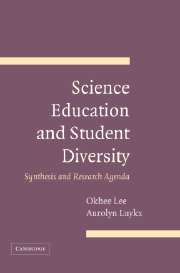Book contents
- Frontmatter
- Contents
- Foreword by Roland G. Tharp
- Acknowledgments
- Introduction
- SECTION I CONCEPTUAL GROUNDING AND POLICY CONTEXT
- SECTION II STUDENT LEARNING AND CLASSROOM PRACTICES
- SECTION III CREATING EQUITABLE LEARNING ENVIRONMENTS
- SECTION IV CONCLUSIONS AND A RESEARCH AGENDA
- Appendix: Method for Research Synthesis
- References
- Index
SECTION III - CREATING EQUITABLE LEARNING ENVIRONMENTS
Published online by Cambridge University Press: 04 December 2009
- Frontmatter
- Contents
- Foreword by Roland G. Tharp
- Acknowledgments
- Introduction
- SECTION I CONCEPTUAL GROUNDING AND POLICY CONTEXT
- SECTION II STUDENT LEARNING AND CLASSROOM PRACTICES
- SECTION III CREATING EQUITABLE LEARNING ENVIRONMENTS
- SECTION IV CONCLUSIONS AND A RESEARCH AGENDA
- Appendix: Method for Research Synthesis
- References
- Index
Summary
To create equitable learning environments for nonmainstream students, teachers' knowledge, beliefs, and practices should evolve throughout their professional careers, continually incorporating our emerging understandings of student diversity and its effects on learning. Additionally, policies and practices at the state, district, and school level should be informed by these understandings in order to provide the necessary support to create such environments. When policies and practices at any level of the education system fail to provide support, teachers (and researchers) face difficulties in promoting students' science learning. Furthermore, there is a growing realization among educators that school science should be closely connected to the knowledge and experiences that nonmainstream students have acquired in their homes and communities. Although the majority of studies were conducted in classroom settings, a few examined specific features of students' home and community environments and their connections to school science. In this section, we present research results in the following areas: (a) science teacher education, (b) school organization and educational policy, and (c) home/community connections to school science.
- Type
- Chapter
- Information
- Science Education and Student DiversitySynthesis and Research Agenda, pp. 101 - 102Publisher: Cambridge University PressPrint publication year: 2006



